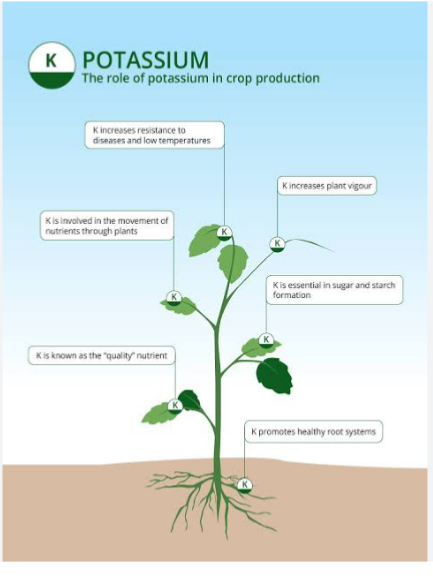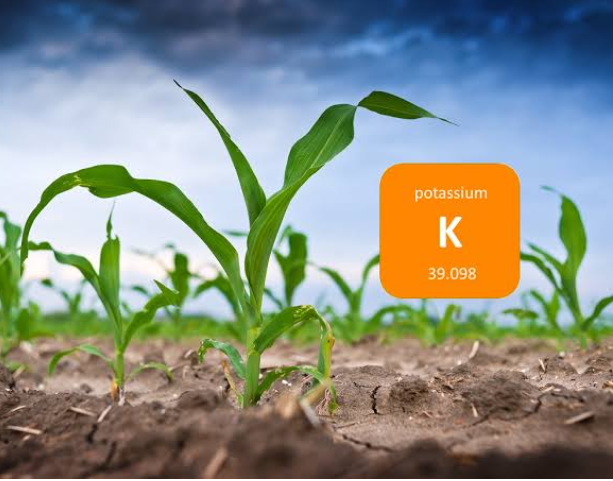
Among the primary essential nutrients required by plant in large quantity is potassium. It is required in the same amount or slightly large amount as nitrogen. Plants uptake potassium (K) in the form of K+. Most of the function of K in plant are indirect in that it is required for other chemical reactions to operate properly. For example, most enzymes in plants require the presence of K to function. High concentration of K is found in active growing points and immature seeds. Potassium forms no organic compounds within the plants, but remain in the ionic K+ form.
Plants generally absorb the majority of their potassium at an earlier growth stage unlike nitrogen and phosphorus which are needed for vegetative growth and fruiting at maturity stage.
SOURCES OF POTASSIUM
Plants can absorb K in the form of K+. There are 3 forms or pools of inorganic K in soil. The three forms include : Unavailable K, Slowly available K and Available and exchangeable K. This will be discussed later.
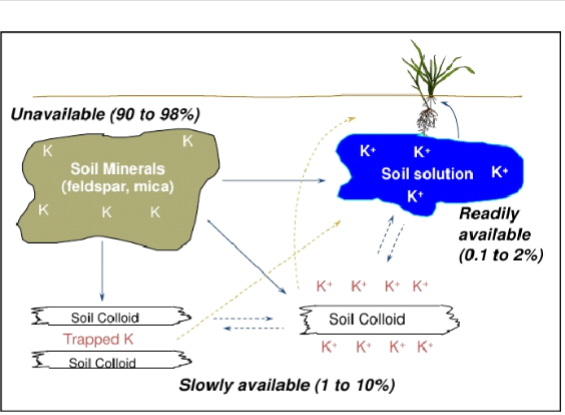
Some of the sources of potassium include: Fertilizers like potassium chloride, potassium sulfate, potassium – magnesium sulfate, potassium nitrate and animal manure. The content of potassium in all these sources are expressed as K2O. But plants absorb potassium as K+ form.
Fertilizer recommendations are expressed as K₂O. To convert from K to K₂O, multiply K by 1.2. To convert from K₂O to K, multiply K₂O by a factor of 0.83.
BENEFITS AND FUNCTIONS OF POTASSIUM
1. Plants use it in photosynthesis
2. They also use it in carbohydrate synthesis and transportation
3. It regulates the osmotic pressure (permeability, water regulation) in Plants
4. Plants use it for protein synthesis
5. It improves plants’ resistance to diseases ( like fungal and viral) and pests
6. Result in vigorous vegetative growth
7. Brings about increase in drought resistant
8. It decreases lodging in cereal plants.
9. It improves soil fertility
10. It stimulate the turgor processes in the cell (promotes the best flow of substances to the plants organs),
11. It assist in the processes of respiration (improves the work of respiratory system ), 12. It activates the work of enzymes
13. It increases the content of sugars, carbohydrates (starch)and vitamins (ascorbic acid);
14. It promotes growth and development of plant roots,
15. It increases tillering and fruit size,
16. It promotes cell wall thickening,
17. It improves the taste of fruits and increases their shelf life.
18. Potassium increases sugar level of the root crops, accumulation of fats in croppers’ seeds, starch content in potato tubers.
19. Potassium assist crop to be resistant to frost and make them tolerant to winter
20. It assist plants to be resistant to stress factors ( such as drought and temperature changes).
From the above benefits and functions of K, using of potassium fertilizers is associated with improved crop quality
POTASSIUM DEFICIENCY SYMPTOMS
Potassium is a highly mobile element in the plant and is translocated from the older to younger tissue.
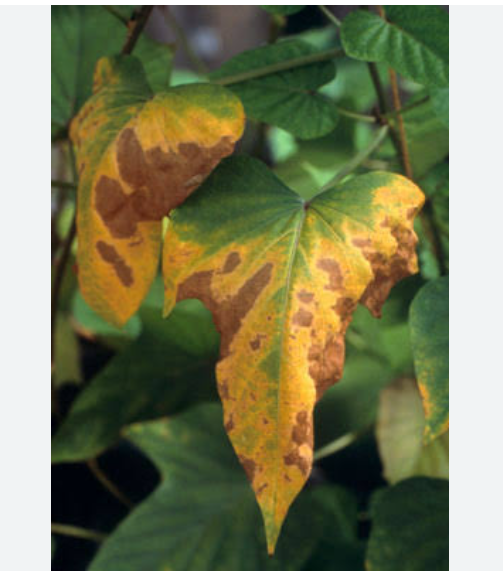
Plants deficient in potassium show stunted growth, and develop poor root system. Older leaves or lower leaves show deficiency symptoms first as potassium is translocated within the plants, progressing towards the top as the severity of the deficiency increases. The older leaves show interveinal Chlorosis or bronzing near the edges of the leaves. As the deficiency continues, the chlorosis develop into a firing or scorch. The firing moves inward until the entire leaves die and they are shed. Since K result in leaf shedding, the ability of the plant to produce carbohydrates is reduced. Hence, yield decreases. Deficiency of K also result in lodging especially in grain crops like maize, wheat etc.
Severe deficiency can also cause defoliation, delayed maturity and plant death. It also result in wrinkling, wilting of leaves, twisting at bottom, shriveling and light green spots on the leaves.
POTASSIUM IN SOIL
Potassium availability in soil depend on the types and amount of minerals in the soil. Potassium in rocks are unavailable (unavailable form) . The primary minerals become available (available form) when the minerals start to decompose. Soil clay around the potassium ion result in K+ fixation as the K+ ion binds to the exchange site of the clay minerals. This fixed potassium cannot be exchanged with other cations in soil solutions. This potassium are called slowly available potassium. This potassium are found in soils like vermiculite and montmorillonites. During acid weathering and during wetting and drying cycles, the slowly available K is released into soil solution which plants can uptake.
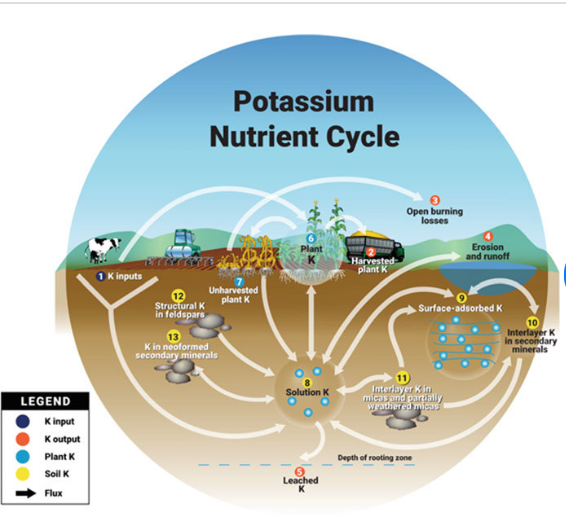
Potassium does not move readily in most soil. It is much less mobile than nitrates (NO3), but more mobile than phosphorus. In sandy soils with low CEC, K can move by mass flow and can easily be leached during heavy rainfall.
K in soil depend on CEC and clay minerals present in the soil. It can be exchanged for other cations on the exchange complex of clay soil. In 2:1 clay minerals like vermiculite and montmorillonites, K may be fixed and be slowly released as the minerals are subjected to weathering and wetting and drying cycle unlike in the 1:1 clay mineral type (such as kaolinitic clays).
CAUSES OF POTASSIUM LOSSES
The amount of potassium content in soils decrease during the period of intensive growth and development of vegetative organs in plants like potatoes, beets and vegetables etc. Some causes of loss of potassium include:
1. LEACHING : Leaching is not a problem on silt and loam soils, but can be a problem on sandy soils. As cations are displaced from exchange sites of soils in acidic soils into solutions, they are prone to leaching from surface soil to lower soil horizons
2. SOIL pH: At low soil pH ( that is, acidic condition) , K compete with other cation of CEC on exchange sites due to high H+ concentration and high soluble aluminum (Al). The H+ and Al displaces all exchangeable cations including K+ from the exchange sites and move them into soil solution. Thus, leaching of the nutrients, especially in coarse or sandy soils or high organic soils.
3. CROP REMOVAL : Crop removal accounts for the largest loss of potassium from soil. Crops take up more potassium than when removed during harvesting.
Potassium can be lost from the soil through crop harvesting. Harvested plant K is the quantity of K in plant material removed from a given area during harvesting.
The rate of K removal per unit area increases as the total K accumulation in harvested plant organs increases. Plants uptake K from the soil and translocate it to its organs like fruits and grain. As K uptake increases, K concentration also increases in plant tissue, resulting in higher yields.
4. LOW SOIL ORGANIC MATTER: Plants uptake potassium and translocate it to all tissues and organs developed on it. Thus, reducing soil K. When the plant is totally harvested without leaving any residues, potassium is totally lost from the soil. When the plant residue is left to decompose into organic matter, potassium is returned back to the soil
5. OTHER NUTRIENTS: Excessive amount of magnesium and calcium in the soil can reduce the amount of K in the soil. Also, because K is bound to clays and organic materials, and adsorbed K is mostly associated with fine soil particles, it can be eroded with particulate material in runoff water and by strong winds. It can also be lost when crop residues are burned in the open.
6. EROSION : K can be lost through erosion from the movement of soil particles from one area to another. Losses can occur in both water and wind erosion. Soil particles eroded from the
field carry adsorbed K with them. Water erosion occurs mostly across the soil surface during heavy rainfall or strong wind blows over the soil surface.
A better understanding of causes of losses of potassium from soil will help farmers proffer solutions and recommendation of fertilizer sources that will help optimize crop yield
WAYS TO MINIMIZE POTASSIUM LOSSES
1. IMPLEMENTING GOOD EROSION CONTROL MEASURES : Liming of soil will prevent the displacement of K from exchange sites. As this is coupled with planting of cover crops, trees with good canopies, use of mulching materials and other erosions preventive measures, potassium becomes available for plant uptake.
2. MAINTAINING GOOD SOIL pH : In acidic soils, H+ and Al+ displace K+ from the exchange site making it prone to leaching, erosion and runoff. But with good liming practices which increases soil pH, potassium will not be lost
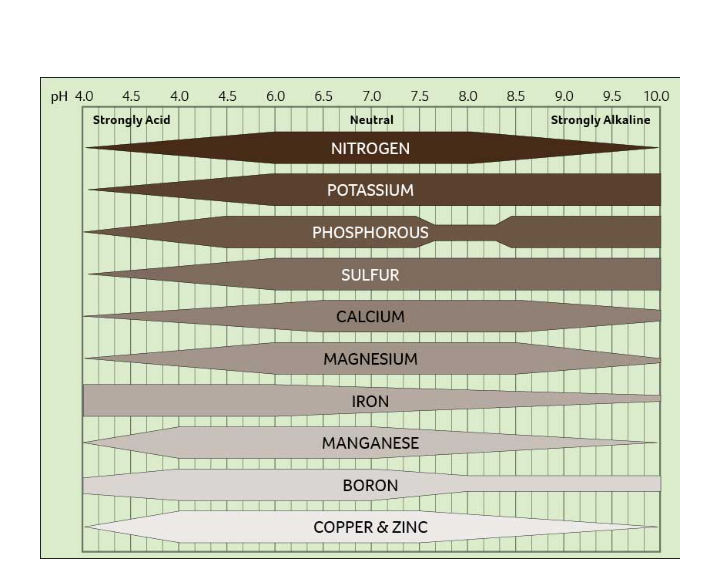
3. INCREASE SOIL CEC: liming helps increase CEC. Therefore, K cannot be lost
4. BUILDING SOIL ORGANIC MATTER : Plant residues contain high amount of potassium which had been uptake from soil during the plant growing period. When this plant residues decompose and the organic matter formed mineralize, potassium is returned back to the soil
5. APPLYING FERTILIZERS USING SPLIT APPLICATION ON SOILS WITH LOW CEC: Split application of fertilizers will make the nutrient available to plant.
6. CARRY OUT SOIL TEST : Soil test is used to determine nutrient status of the soil and for fertilizer recommendation. Soil test will predict the level of availability of K in soil and whether or not there is need for ammendment
7. LIMING : When an acidic soil is limed, the pH and CEC increases. Therefore, H+ and Al+ will be displaced from the exchange sites and replaced by basic cations. This would make the soil have greater capacity to supply potassium for plant growth.

ANTAGONISTIC AND SYNAGISTIC INTERACTION OF POTASSIUM AND OTHER NUTRIENT
ANTAGONISM
Antagonistic nutrient interaction involves an overdose of a certain element displacing another element.Thus, showing signs of nutrient deficiency. For example,
High level of nitrogen can inhibit the availability of potassium to crops. High level of phosphate can reduce the uptake of potassium by plant. High level of potash can reduce the availability of Magnesium. High level of Calcium can inhibit the availability of Potassium. And Potassium and Calcium ions do inhibit the uptake of Magnesium ions as these elements compete in uptake.
SYNAGISM
One nutrient increases the availability of another nutrient in the soil, it promotes its uptake into the plant, or it enhances its function in plant metabolism.
Most macronutrients have synergistic responses for example, N and P or N and K. Because of this synergism, less N can be used when applied with K, and still achieve the same yield. This would help farmers reduce investment cost and create a safer environment. Also, studies have shown the synergistic effects of K and Mg on photosynthesis, carbohydrate transport and allocation, nitrogen metabolism, and turgor regulation. Both Mg2+ and K+ play important roles in maintaining cellular pH balance, and K+, a major osmolyte in vacuoles, is essential for stomatal opening.
